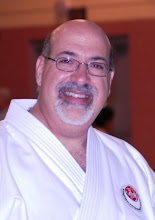 Dojo Etiquette
Dojo Etiquetteby Master Teruyuki Okazaki
In the last Spotlight , I finished Master Funakoshi's Niju Kun and now it is time to discuss rei gi saho, or dojo etiquette. As Master Funakoshi states, "Without courtesy you cannot practice Karate-do."
This applies not only to our training but to life in general.
The word "dojo" is actually two words. "do" which means "the way" or "the path" and ‘jo’ which means ‘the place’. When the two words are combined it means "the place where the way is studied’. The dojo is the place where we learn to live together as human beings. This is a serious subject and therefore we must always follow dojo etiquette.
This is the first step to practicing Karate-do.
Upon entering the doorway of the dojo, face shomen side, and bow. This is called ritsu-rei and shows deep respect to the teachings of Master Funakoshi as well as the seriousness of your study. Always try to arrive to class 10-15 minutes early so you have time to stretch and practice.
When the instructor says line up, move as fast as possible to form the line. Remember, more than two steps, you must run.
When making seiza, always go down left knee first, then the right knee. The hands should rest comfortably on the thighs. Sitting in seiza is much more than just kneeling. Historically, the samurai always had to be ready to defend themselves at any time. Since the sword was always carried on the left hip, the left knee went down first so they could draw the sword without injuring themselves. Always keep both balls of the feet in contact with the floor when kneeling down or rising to the standing position. If your posture is not straight and your feet not gripping the floor, then it is almost impossible to effectively defend against an opponent. Try this for yourself. After making seiza, then you must close your eyes in mokuso. This term means to cleanse or make blank your mind to prepare for training. You have to forget all your thoughts and concentrate only on what the instructor is trying to convey. By only existing in the moment can you really learn.
After the command mokuso yame, open your eyes. Shomen ni rei- bow to the shomen side, Sensei ni rei, bow to the instructor. Every time you bow push your ego further down and become as empty as possible. Next issue we will discuss dojo manners during class.
SAFETY FIRST.
No horse play.
Practice good distance and control with your partner.
Notify the instructor of any injury or illness.
Keep toe and finger nails short.
No jewelry.
No gum, candy, or food during training.
Drink water.
RESPECT ALWAYS.
Arrive on time in a clean body and gi; be prepared to train.
Bow before entering the training floor.
Bow when facing/leaving a partner.
Train with enthusiasm and strong spirit.
Do not disrupt the class by talking.
Do not delay class: move to a new position quickly; ask only brief questions.
Maintain good posture with hands at your sides; do not lean or lounge.
Turn away from shomen (front of training area) or your partner when making adjustments to your gi, sneezing, coughing, etc.
Notify the instructor of extended absence.
Keep your dojo clean.














